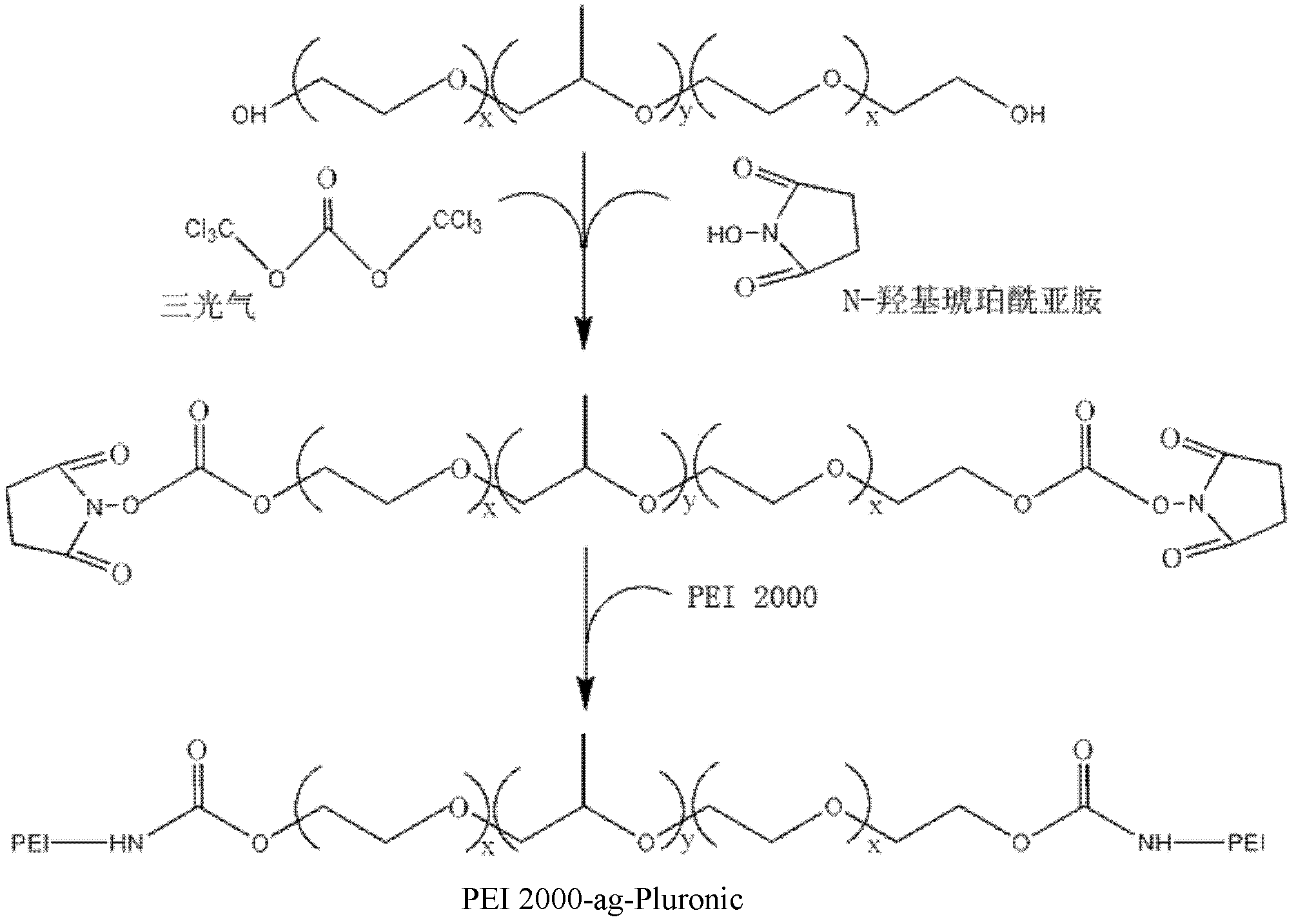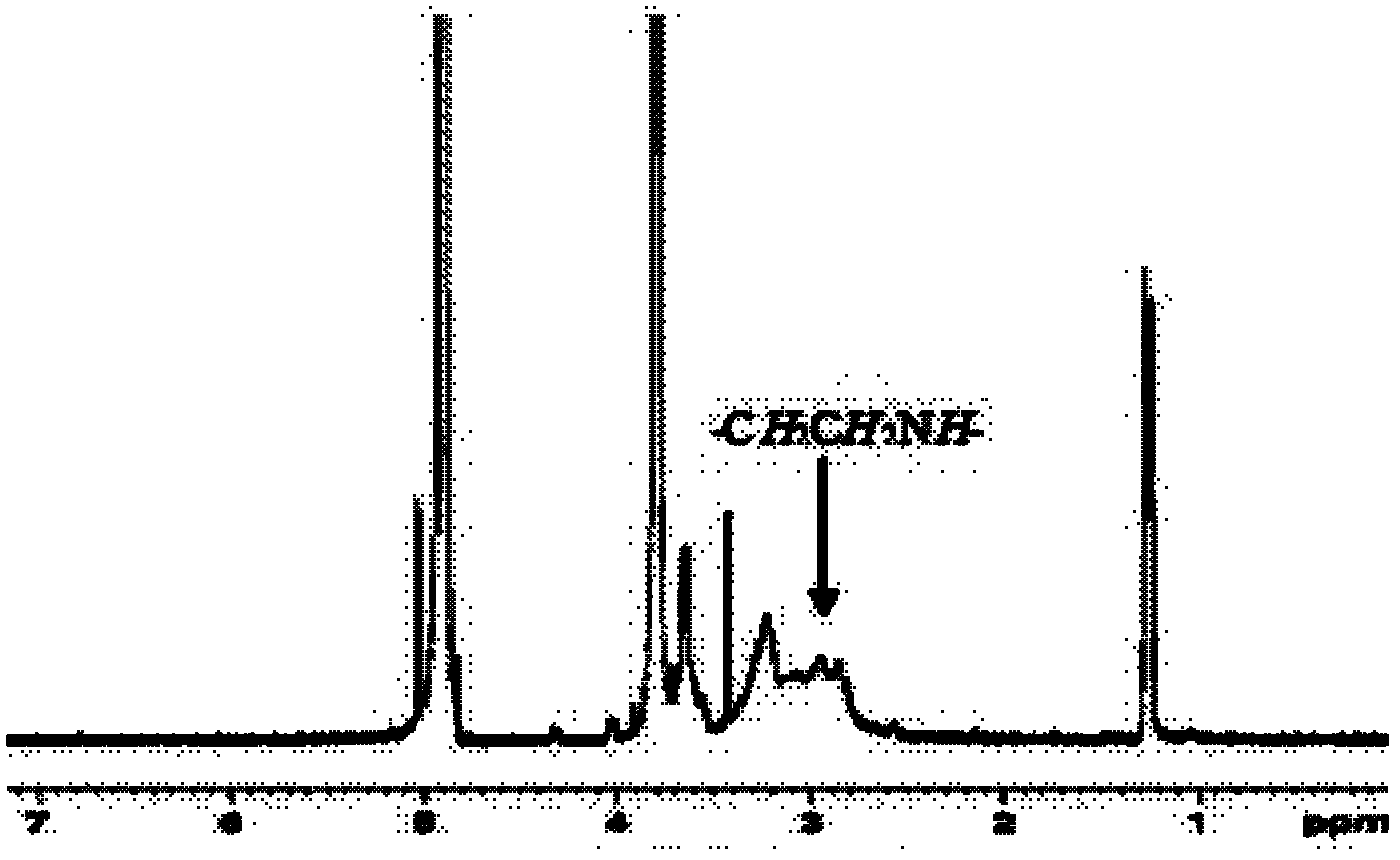Polyethylenimine derivative, preparation method thereof and application thereof
A polyethyleneimine and derivative technology, applied in the field of medicine, can solve the problems of reduced affinity, low transfection efficiency, inaccessibility of target genes, etc., and achieve the effects of low cytotoxicity and high transfection efficiency
- Summary
- Abstract
- Description
- Claims
- Application Information
AI Technical Summary
Problems solved by technology
Method used
Image
Examples
preparation example Construction
[0028] The preparation method of polyethyleneimine derivative of the present invention is as follows (see figure 1 ):
[0029] (A) Activation of hydroxyl groups at both ends of poloxamers
[0030] Weigh an appropriate amount of poloxamer after water removal, add twice the molar amount of triphosgene, dissolve in a mixed solution of anhydrous toluene and anhydrous dichloromethane, and react overnight with magnetic stirring at room temperature. Remove the solvent by rotary evaporation in vacuo, then dissolve with an appropriate amount of anhydrous toluene and anhydrous methylene chloride, then add an appropriate amount of N-hydroxysuccinimide, and under magnetic stirring, anhydrous triethylamine (dissolved in 4ml anhydrous methylene chloride ) was added dropwise to the reaction solution, and the stirring reaction was continued for about 4h. After the reaction is complete, filter the reaction solution and remove the solvent by vacuum rotary evaporation again, dissolve the obtai...
Embodiment 1
[0034] Example 1 Preparation of Polyethyleneimine Modified by Poloxamer
[0035] Weigh 1.2mmol of poloxamer (F68=10.31g, P105=7.86g, P123=6.94g, L61=2.43g, BASF, Germany) after water removal, dissolve in anhydrous toluene and anhydrous dichloromethane To the mixed solution, 0.712 g of triphosgene (2.4 mmol) was added, and the reaction was carried out under magnetic stirring overnight at room temperature. The solvent was removed by rotary evaporation in vacuo, then dissolved with an appropriate amount of anhydrous toluene and anhydrous dichloromethane, then 0.274 g (2.4 mmol) of N-hydroxysuccinimide was added, and anhydrous triethylamine (0.4 ml dissolved in 4ml of anhydrous dichloromethane) was added dropwise to the reaction solution, and the stirring reaction was continued for about 4h. After the reaction is complete, the reaction solution is filtered and the solvent is removed by vacuum rotary evaporation again, the obtained residue is dissolved in 50ml of ethyl acetate, th...
Embodiment 2
[0037] Example 2 Cytotoxicity Evaluation Experiment of Polyethyleneimine Modified by Poloxamer
[0038] Hela cells were seeded on a 96-well plate, about 10,000 cells per well, and after 24 hours of culture, a series of concentrations (0, 4, 6, 8, 16, 24, 32 μg / ml) of PEI 25kd and modified PEI 2000, continue to culture for 24h, MTT assay cytotoxicity. from image 3 It can be seen that compared with PEI 25kd, the modified PEI 2000 showed stronger cell activity at each concentration, especially at high concentrations, the Hela cells treated with the modified PEI 2000 still showed very strong activity. The high biological activity provides an effective way to solve the problem of excessive cytotoxicity of PEI as a gene carrier. The main reason is that the polymerization product of low molecular weight PEI and poloxamer can be degraded into small molecules in vivo Fragments, which can be metabolized and excreted by somatic cells, reduce aggregation.
PUM
 Login to View More
Login to View More Abstract
Description
Claims
Application Information
 Login to View More
Login to View More - R&D
- Intellectual Property
- Life Sciences
- Materials
- Tech Scout
- Unparalleled Data Quality
- Higher Quality Content
- 60% Fewer Hallucinations
Browse by: Latest US Patents, China's latest patents, Technical Efficacy Thesaurus, Application Domain, Technology Topic, Popular Technical Reports.
© 2025 PatSnap. All rights reserved.Legal|Privacy policy|Modern Slavery Act Transparency Statement|Sitemap|About US| Contact US: help@patsnap.com



